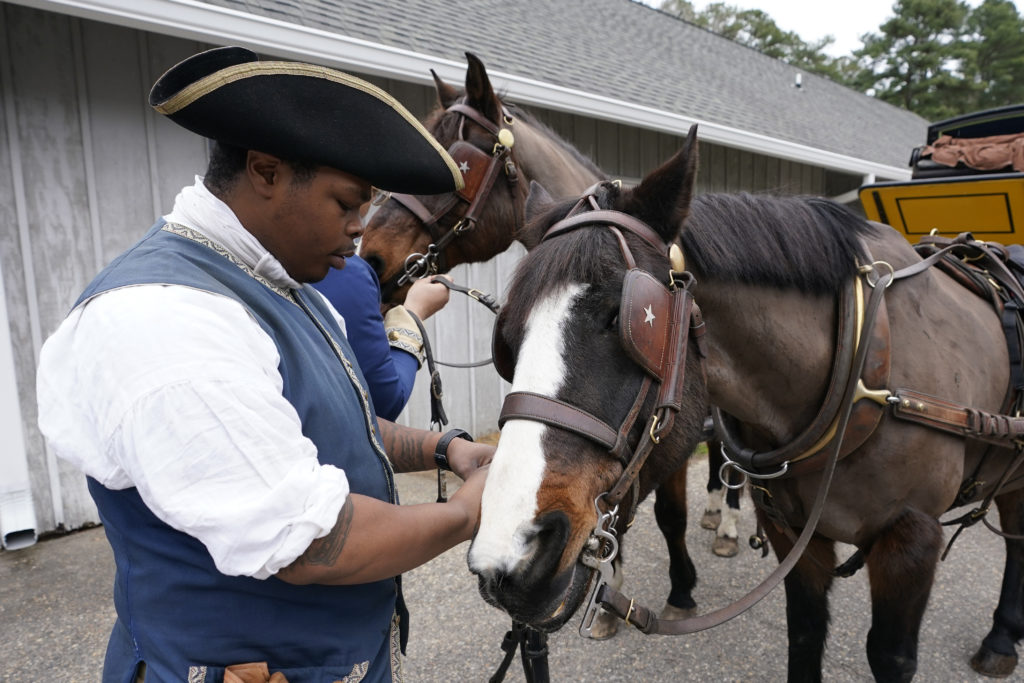General News
Meropi Kyriacou Honored as TNH Educator of the Year
NEW YORK – Meropi Kyriacou, the new Principal of The Cathedral School in Manhattan, was honored as The National Herald’s Educator of the Year.

NORFOLK, Va. — The Black men who drove horse-drawn carriages through the streets of Colonial Williamsburg in Virginia were both everywhere and invisible during the Jim Crow era.
Their wooden coaches helped conjure up the late 18th Century for visitors including Queen Elizabeth, Sir Winston Churchill and then-Gen. Dwight Eisenhower. And yet the men were forced to use separate bathrooms and water fountains, among the many other sanctioned indignities of segregation.
“These guys were resilient,” said Paul Undra Jeter, the living history museum’s director of coach and livestock. “I tell my young (Black) drivers that they face nothing compared to what they faced back in the day because (racism) was okay.”
Colonial Williamsburg has begun to honor the coachmen by naming a new carriage after one of them, with hopes that more will follow. The first is for Benjamin Spraggins, who was sometimes said to be the most-photographed man in Williamsburg — although few captions bore his name. A carriage processional and ceremony will also celebrate Spraggins on Saturday.

The tribute is part of the museum’s ongoing reckoning over race and its past storytelling about the country’s origins and the role of Black Americans.
Colonial Williamsburg tells the story of Virginia’s late 1700s capital and includes more than 400 restored or reconstructed buildings. The museum was founded in 1926 but did not tell Black stories until 1979. More than half of the people who lived in the colonial capital were Black, and many were enslaved.
Segregation-era coachmen were exclusively Black. And they were part of a much larger Black workforce that underpinned the museum’s operations as cooks, maintenance workers and landscapers, said Ywone Edwards-Ingram, a professor in the Department of Focused Inquiry at Virginia Commonwealth University.
In a 2014 scholarly article, Edwards-Ingram pushed back against 1979 as a watershed year for inclusion because Black people had long worked there, sometimes in highly visible roles, even if they were not officially interpreters.
In the 1890s, before the museum was founded, Black residents served as guides for sightseers and later helped reconstruct buildings for the museum. They also worked in archaeology to help uncover physical evidence of the colonial capital. And some dressed in costume, performing tasks such as candle making, Edwards-Ingram said.
She said the segregation-era coachmen essentially were interpreters — even ambassadors — for passengers and dignitaries.
They were also highly skilled at training horses and “every bit the craftsmen that our blacksmiths and silversmiths were,” said Carl Childs, the museum’s executive director of research and education.
But they received little recognition.
“When you look at the photograph collections of Colonial Williamsburg, many times their names were not even mentioned,” Edwards-Ingram said. “That’s why it’s important to name that carriage. You’re making things visible.”

Driving coaches from 1937 to 1953, Spraggins gave “his perspective of the town” and “took an active role in the cultural performance of the carriage ride, basically controlling the visitors’ experiences,” Edwards-Ingram wrote in her article.
Spraggins died in 1987. A grandson, Darrell Jimmerson, said his grandfather was a humble and hard-working man. And while Jimmerson never heard any specific stories, he has no doubt Spraggins and other Black coachmen experienced racism on the job.
They still do.
Jeter, the museum’s coach and livestock director and the first Black person to have the job, said Colonial Williamsburg now employs Black, white and female carriage drivers. The Black drivers sometimes hear racist remarks from visitors walking by — or someone falsely claims Black people never lived there or drove carriages.
The carriage drivers stick up for themselves, while other guests support them, Jeter said. And the people who make such comments “usually shut it up and kind of cowardly back off because they’re making a scene.”
“You got more people who disagree than who agree with them,” Jeter said.
NEW YORK – Meropi Kyriacou, the new Principal of The Cathedral School in Manhattan, was honored as The National Herald’s Educator of the Year.

MELBOURNE, Australia (AP) — More than 100 long-finned pilot whales that beached on the western Australian coast Thursday have returned to sea, while 29 died on the shore, officials said.
NEW YORK – With the commitment to upgrade their relationship and to improve the services of the Municipality for expatriate Chians, the Mayor of Chios Dr.
APRIL 27TH: On this day in 1748, Adamantios Korais, the Greek humanist scholar, was born in Smyrna.
Irene Tahliambouris, the 68-year-old Greek-American who was the victim in a brutal robbery and assault at the entrance of the Church of St.
LOS ANGELES - LeBron James and the Los Angeles Lakers are still alive.